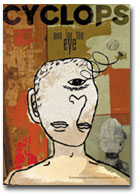Cyclops
Various authors
Conundrum Press, 2003
Reviewed by Rob Thomas
 Cyclops gathers the work of twenty-five contemporary Canadian author-artists. Its focus is autobiography and stories that explore the human condition. Aside from a sly wink at the anthologyís visual character and an allusion to the Odyssey,
Cyclops is also a bilingual name; it is understood in French and English. Many of these comics appear in English translation for the first time. Other comics, by English-speaking authors, appear along side the work of their French counterparts for the first time. Cyclops gathers the work of twenty-five contemporary Canadian author-artists. Its focus is autobiography and stories that explore the human condition. Aside from a sly wink at the anthologyís visual character and an allusion to the Odyssey,
Cyclops is also a bilingual name; it is understood in French and English. Many of these comics appear in English translation for the first time. Other comics, by English-speaking authors, appear along side the work of their French counterparts for the first time.
An anthology of comics is a little unique in itself. A book that collects fresh work by underground authors is still more unique. So it almost goes without saying that
Cyclops is an ambition project. Folks from Quebec will recognize editors Helene Brosseau and Marc Tessier as well as names like Michel Rabagliati and Bernie Mireault. Many of the contributors come from the Montreal scene. Others might recognize Londonís Marc Bell and others. Brosseau and Tessier have assembled an eclectic mix of pieces. Thatís exciting for a reader but it makes a reviewerís job difficult. All I can do is cobble together some general descriptions.
Fulfilling the collectionís edgy quotient are works by Helene Brosseam, Richard Suicide and Caro Carron. Brosseamís fanciful bestiary "Teratology and Basic Etiquette" presents some pretty odd critters like The Lewd and Cruel Feathered Zygocephalod or the Douotone Castrator which "haunts the sewers and surfaces to feed on the balls of those who dare to shit when the moon is full." Meanwhile, the Crumby, zombie populated metropolis of Richard Suicideís "Life is a Boat but not on Mondays" is backdrop for a cautionary tale of insurance scams, greed and nosey zombie landlord. Caro Carronís "Give me 9 lives baby" is the dynamo of these pieces. Her jive addled hallucinations about a cat that will play while the master is a way takes a thoughtful look at women, sexuality and rebellion.
"Of course like all suburban houses, the basement was full of monsters and ghosts," this pithy insight comes from Lime Gamacheís pint sized protagonist. Gamacheís "When I was small, I wasnít tall" is a coming of age story about a witch who hides out in the attic. Of course, the witch escapes from the attic and takes up residence in the young girlís mind. Where it is eventually recognized for what it is, a fantasy? Perhaps? Luckily, the story ends and sidesteps any cornball resolution. And thatís good. The coming of age strip is well on itís way to becoming a very tiresome cliche. Strips by Gamache and Odom both manage to keep the genre fresh. Obomís story, which is untitled, tells of parental divorce and a cleaved life spent growing up in Montreal, Paris and in between.
In a similarly mode, Cyclops includes some tradition fantasy (Phil Angers and Alexandre Lafleur) and one or two cartoons. Of these, Robert Bottenbergís "Between Gentleman" and Leif Tandeís "Kamasutra" are highlights. "Between Gentleman" tracks an imagination dual between two precocious kids. Iíll leave the "Kamasutra" material to your imagination. Then of course there is the giddy surrealism of Marc Bellís and Peter Thompsonís tag-team doodle "The Two Towers."
Marc Richard, Alain Reno and Marc Tessier hold up the art-house side of the whole enterprise. Their comics are essentially visual poems. Renoís "End of Destiny" tells a dark story of family origins in a wonderful faux-dadaist pastiche of newspaper clippings. Tessierís "Searching for egress into the world of light and beauty" is probably the most original creation in the anthology. In it, Tessier uses passages from Henry Millerís
The Colossus of Maroussi to narrate a photo-log of his own travels in India.
Cyclops even offers social realism in the form of Jean-Pierre Chansigaud "Chers voisin" and "Below the poverty line." The first is a story and the second is a poem. Both deal with everyday life in Montrealís St. Henri
neighbourhood.
Ultimately, Cyclops is a testament to Canadaís (and especially Montrealís) vigorous narrative arts scene. Further, itís a serious kick in the pants to those who speak of narrative art as though it were homogenous or merely a genre. Itís a medium. Letís face it. Art Spiegelman and Neil Gaiman have as much in common as Primo Levi and Stephen King. And, as Mario Cholette points out in his introduction, these comics arise from a "deeply authentic movement, generously offering itself." Cholette invites us to take advantage of it. Reading this book would be a wonderful start.
Rob Thomas is a book reviewer and journalist. He has no narrative art expertise. His knowledge of the topic has been gleaned entirely from Scott McCloudís book
Understanding Comics and a ring and lantern generously provided by the Galactic Guardians of
Oa. |